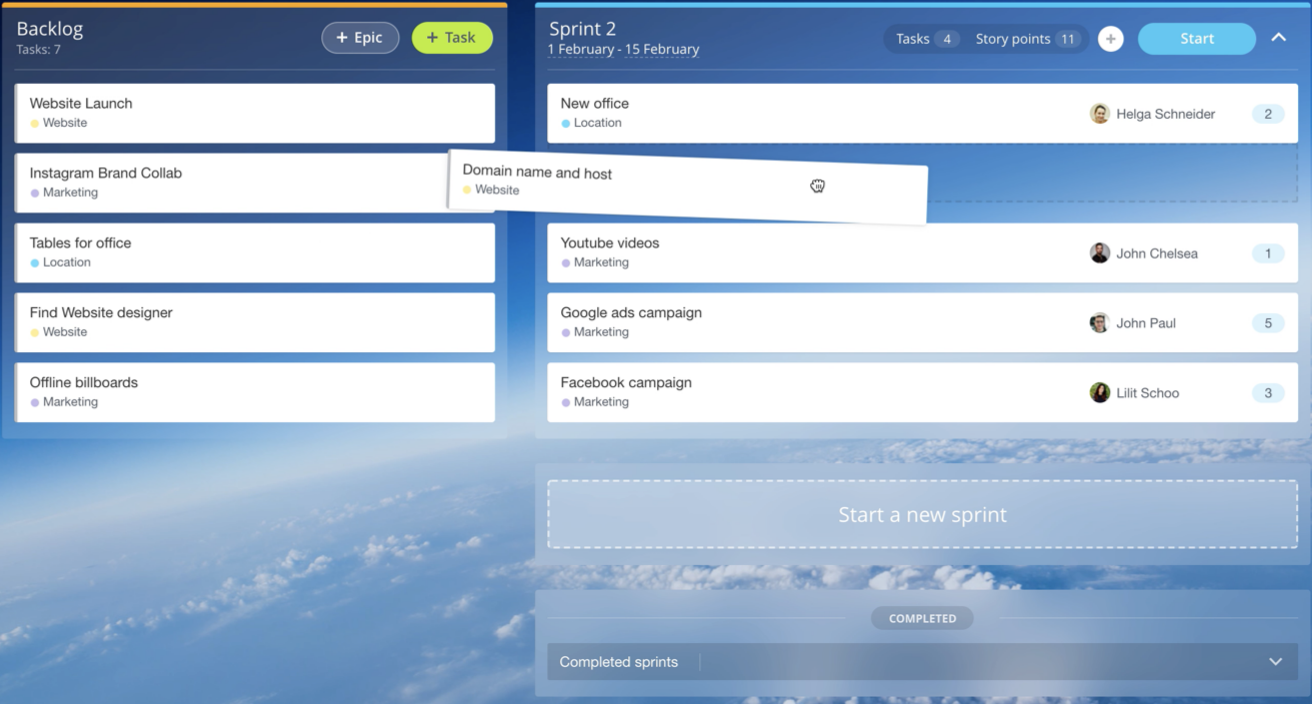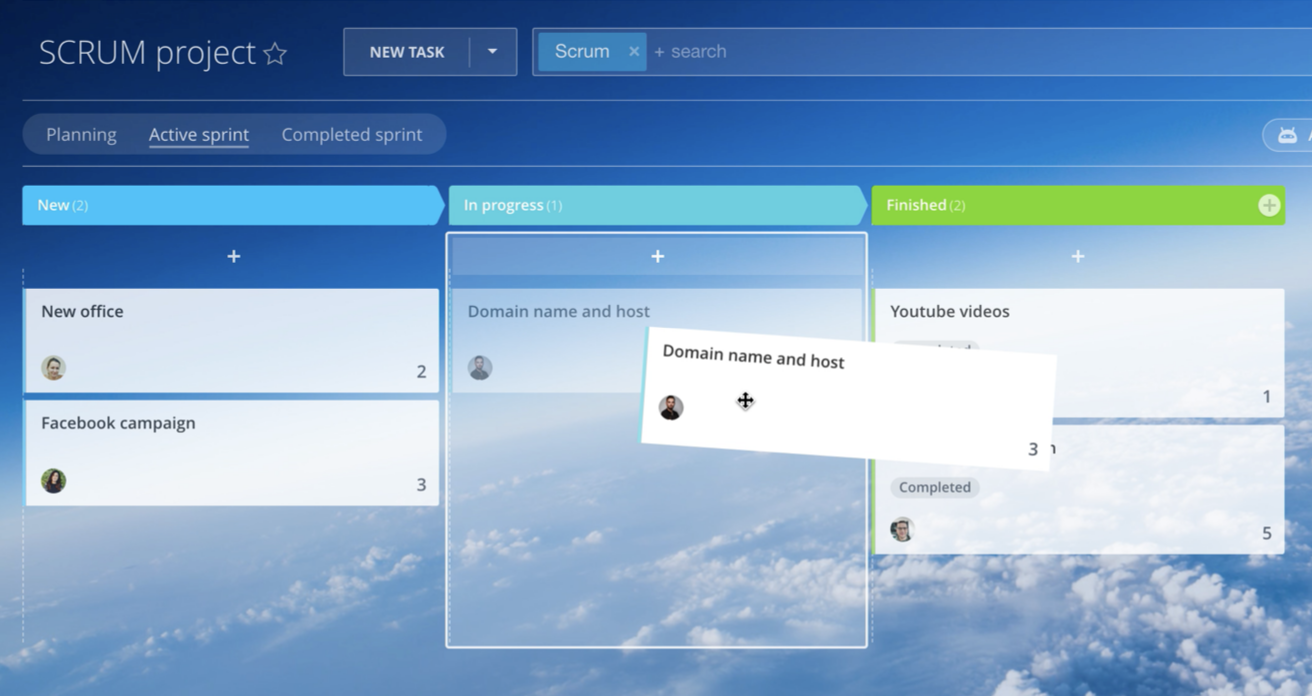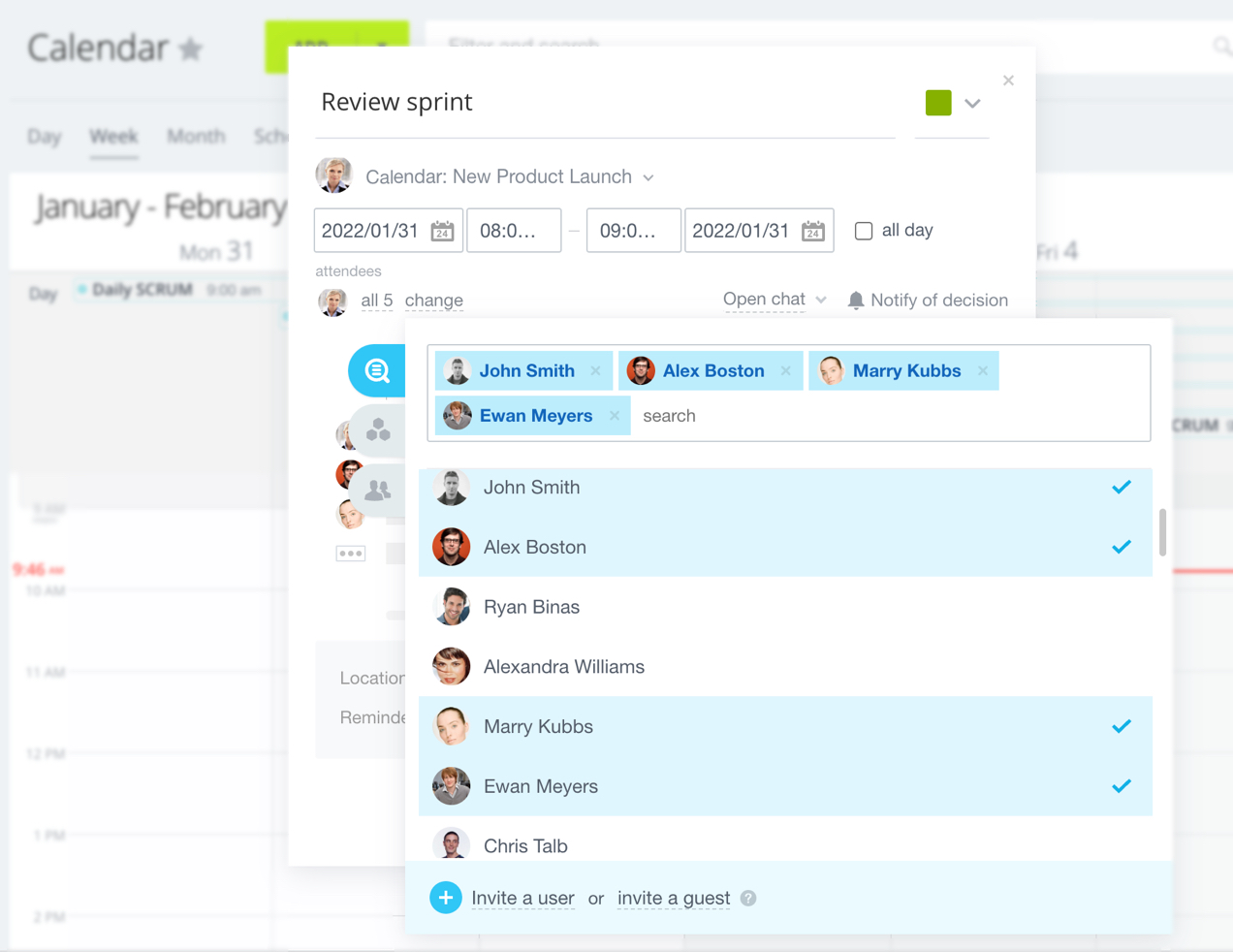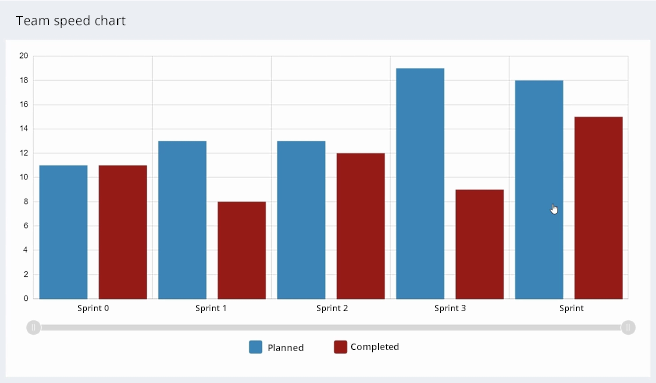Scrum is really not that complicated: you just pick tasks and set goals for a particular sprint and accomplish them within that sprint. Then, you present the results and start another cycle.
Work scenarios for your Scrum team in Bitrix24
2 min 43 sec
Sprint planning
Time to plan your first sprint and then launch it! To do this, define your goals and pick the tasks from the backlog.
Sprint goal
Refine the backlog and prioritize the tasks. Which of them should become a part of the upcoming sprint? Set a goal that must be achieved during the sprint.
This goal can be set only by the Product Owner. It’s up to him/her to prioritize the tasks and pick the ones that should be done first.
Example
Business development tasks
A goal like “create new customer support scripts” is not good enough.
A good goal would answer the question WHY you need new sales scripts. E.g., to decrease the churn rate or the number of customer complaints.
Example
Product-oriented tasks
If your goal is to “create new sales scripts”, you might want to think about changing it.
An example of a better goal is to “increase the conversion rate from 0.8% from 1.0%”, which will get the team thinking about a wider range of possible solutions (and tasks stemming from them), which may or may not include creating a new sales script.
Example
Creative tasks
A goal like “redesign the website” won’t do.
A more specific, targeted goal would be better - for example, “simplify navigation on the checkout page”.
Formulating a sprint goal that focuses on the bigger picture helps the team to concentrate on what’s really important and produce tangible results faster.
That’s what Scrum is all about: maximizing the value that the product creates for its users.
Sprint tasks
Together with the Product Owner, the team discusses the tasks that should become a part of the upcoming sprint. Those who will have to work on these tasks rate them in terms of difficulty and resources.
Only the team can decide how many tasks should be worked on during a sprint.

Sometimes, when a task is rather big and complex, it’s not easy to tell how long it will take to complete and whether any additional problems may arise.
In this case, you can decompose this big task into a series of smaller subtasks and assign them to different team members. Or, this big task might even become an epic that will take more than one sprint to complete.
Tip for advanced users
Using Story Points for estimating
To estimate task difficulty in Scrum, a thing called Story Points is used.
Although Story Points are a part of the Scrum methodology, you don’t necessarily have to use them.
How to use Story Points? You take a simple task that the team can complete in X amount of time and with Y amount of effort - that gives you one Story Point. Then, you rate all the other tasks against this metric.
E.g., this task gets 5 Story Points, that task gets 10 Story Points, and so on.
Just keep the scale consistent. A 5-story-point task will take twice less time and effort than a 10-story-point task. If a task is hard to estimate, you can always break it down into subtasks. And if it’s too big to decompose - just make it an epic.
Using Story Points might feel awkward at first but you will soon find that they have a lot of benefits:
- For the team - using abstract units of measurement (such as Story Points) often gives you a more precise estimation than using hours.
- For the Product Owner - a better understanding of how long it will actually take to complete a task. It will take you no more than 3-4 sprints to figure out the actual speed and productivity of your team - e.g., how many story points they can actually complete within a standard 2-week sprint.
Now you’re ready to plan your sprint! Get your team together for an online meeting right inside Bitrix24!
Once you’ve set your sprint goals and tasks, it’s time to launch that sprint!

Executing sprints
Manage work progress
The team sees the tasks (and their statuses) right up on the Kanban board. Statuses can be customized - you can add, remove, or rename them as you deem appropriate.

Before completing a task, your team members will have to go through a checklist (remember the DOD?) to make sure none of the important details are missed. Different types of tasks can feature different checklists.
The Burnup Chart will show you the team’s progress as they complete the tasks from the sprint. This might come in handy in a situation when you have lots of different tasks, some of which have to be completed at a different time.
Communication is the key
Scrum is all about close collaboration and communication between all the team members, whether they are in the office or working from home. Bitrix24 features a wide choice of communication tools for your Scrum team - you can use our chats, calls, or online meetings without having to resort to any other software.

There’s no “I” in Scrum - if someone failed to complete their tasks on time, it means the whole team failed the sprint. That’s why it’s so important for the whole team to take part in discussions, share their progress, and also voice their concerns.
Stick to the schedule
When you use Scrum, you absolutely must follow the schedule you’ve created for your team.
Our Calendar will send your a friendly reminder 15 minutes prior to every scheduled event so that you’ll never miss a single meeting.
Once a sprint is finished, the team presents its results to the stakeholders. To invite these people, add them to the appropriate event in the Calendar or simply connect them to your online video conference.

Assess results
Achieving goals
Keep in mind that every sprint has a goal, which ultimately boils down to delivering value. During a sprint review meeting, you and the team have to figure out whether that goal has been achieved. If not - what prevented the team from achieving it.
Make notes and mark ideas along the way - you may need them for planning the next sprints.
The sprint retrospective meeting is when the team shares their opinions and concerns regarding the completed body of work while also offering ideas for improvement. Any obstacle that your team might encounter on their way to the ultimate productivity must be removed.
Plan ahead and plan thoroughly
After a sprint is finished, you will see task reports from all your team members. If some of the tasks have not been completed, you can include them in the next sprint or move them back to the backlog.
If you use Story Points, then Bitrix24 will show you a detailed report: how many Story Points were planned and how many were actually completed during the sprint. The more sprints you finish, the more data you will get, which will allow you to plan more accurately next time.

Next time, when you’re planning a sprint, you will just have to take a quick glance at the Story Points involved to estimate the time required for their completion.
Scrum is a highly flexible tool that you can easily customize to your needs, taking bits and pieces that fit your particular business scenario.
What binds them all together is the overall iterative approach, team collaboration, and constant small improvements instead of big updates.
Switching to Scrum might give your company a nice little push forward in terms of new approaches and methods that you can use to develop your business and take it to the next level.
And Bitrix24 is here to help, always by your side 24/7.

Alexander Polozhevets
Your Bitrix24 Scrum advisor
Self-check time
Who sets the sprint goal?
Select answer
Who decides how many tasks should be worked on during a sprint?
Select answer
Why is communication so important in a Scrum team?
Select one or more correct answers:
Assessing the results of the 1st sprint is done to:
Select one or more correct answers:



